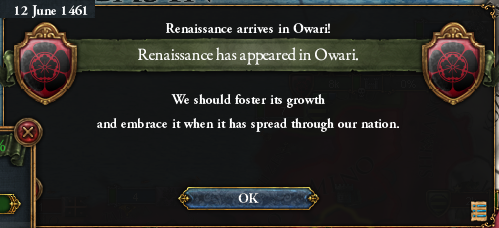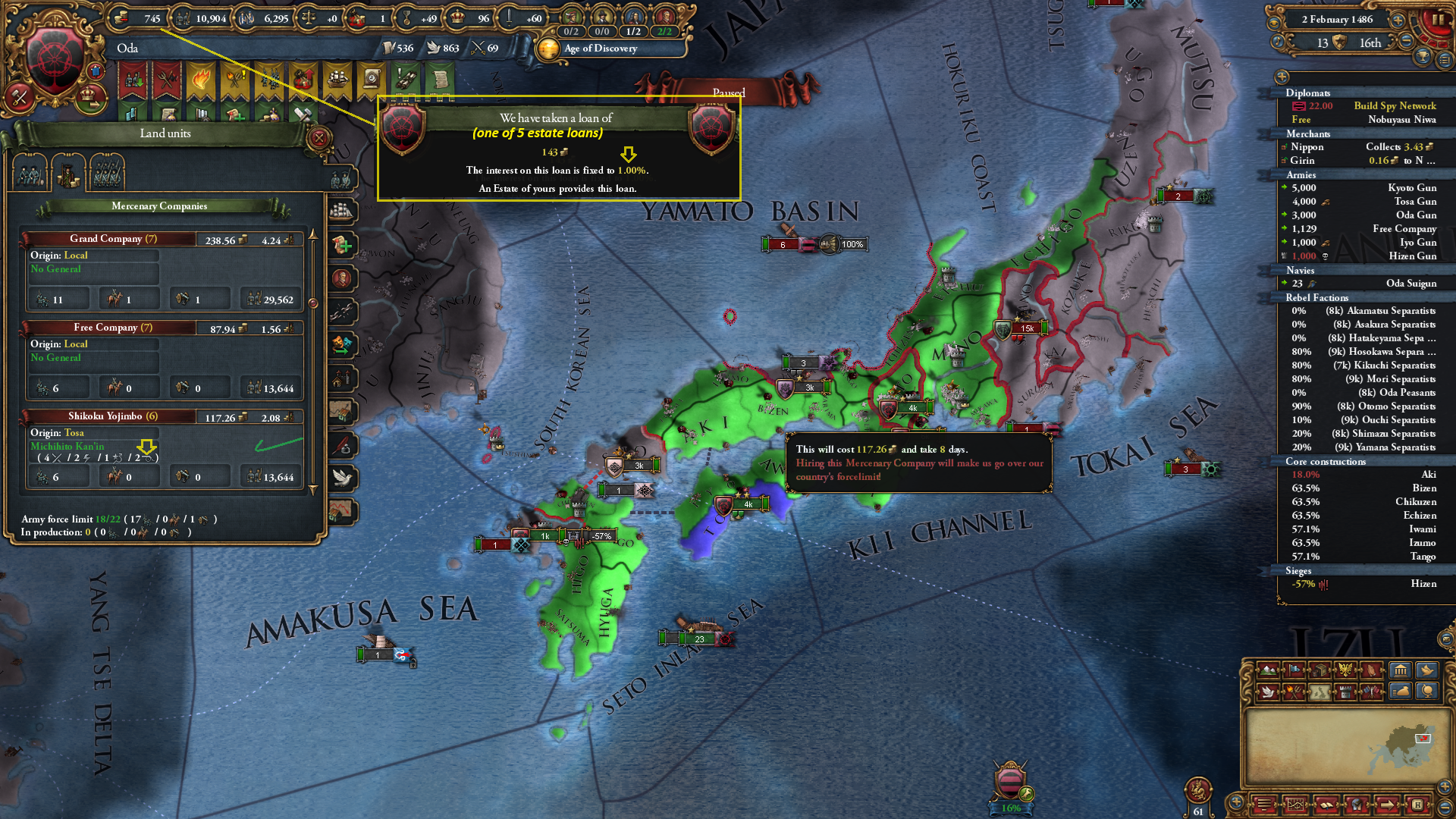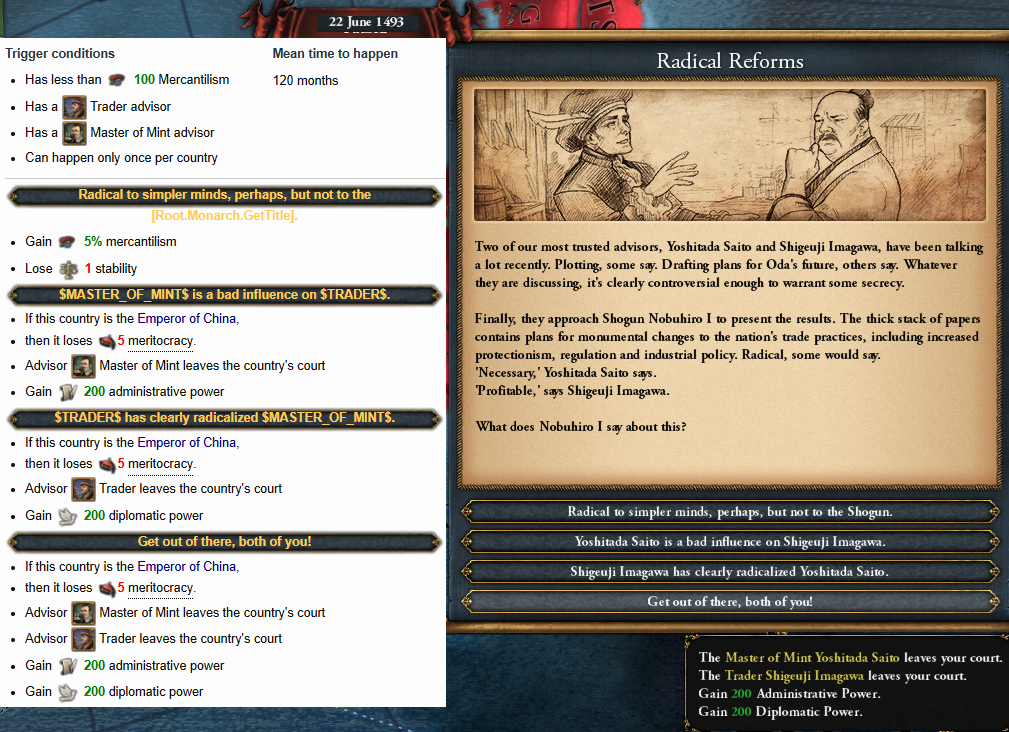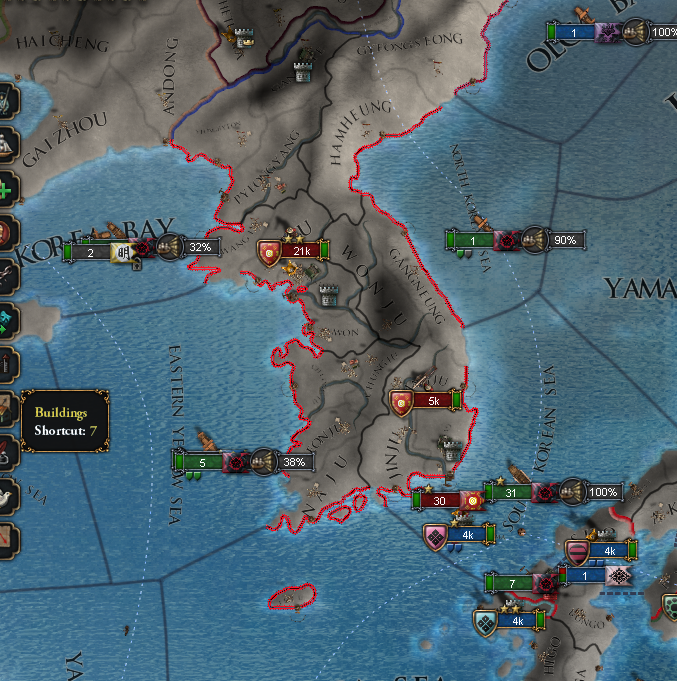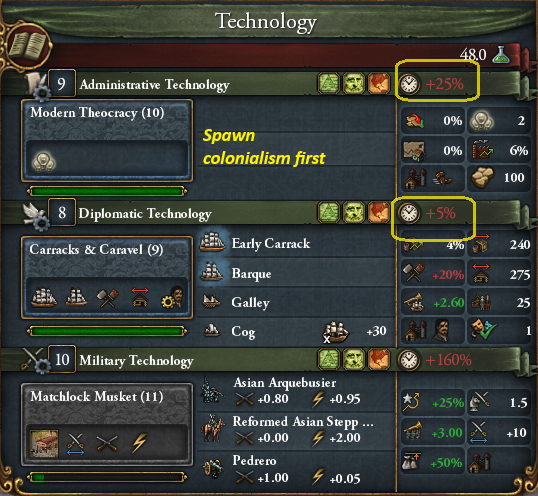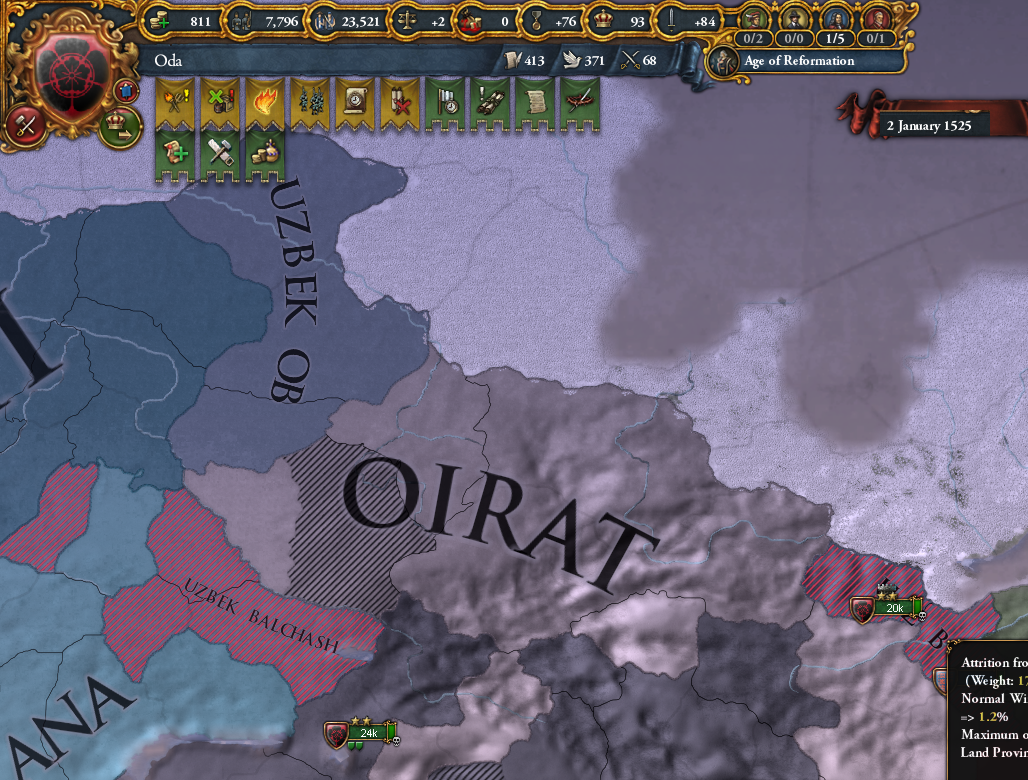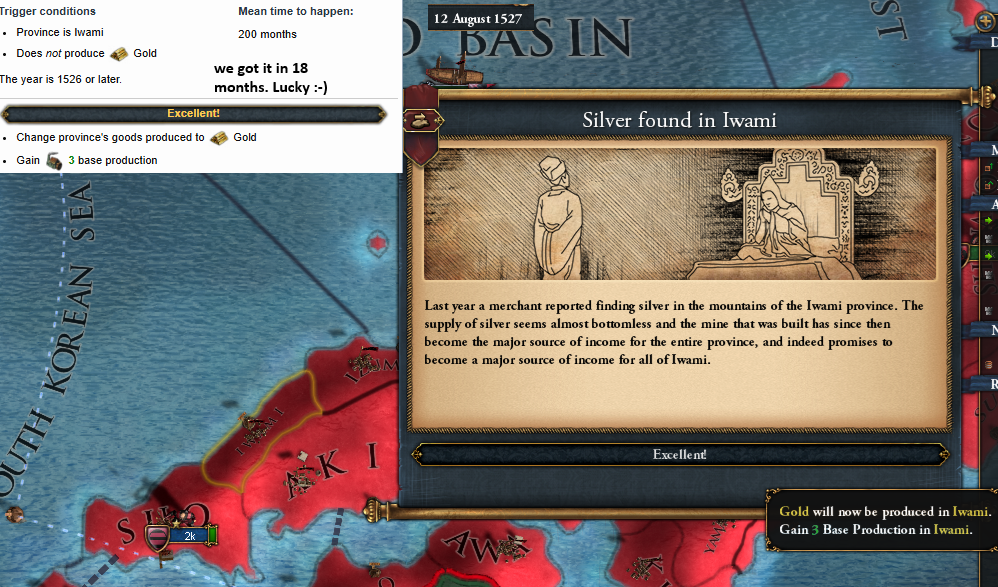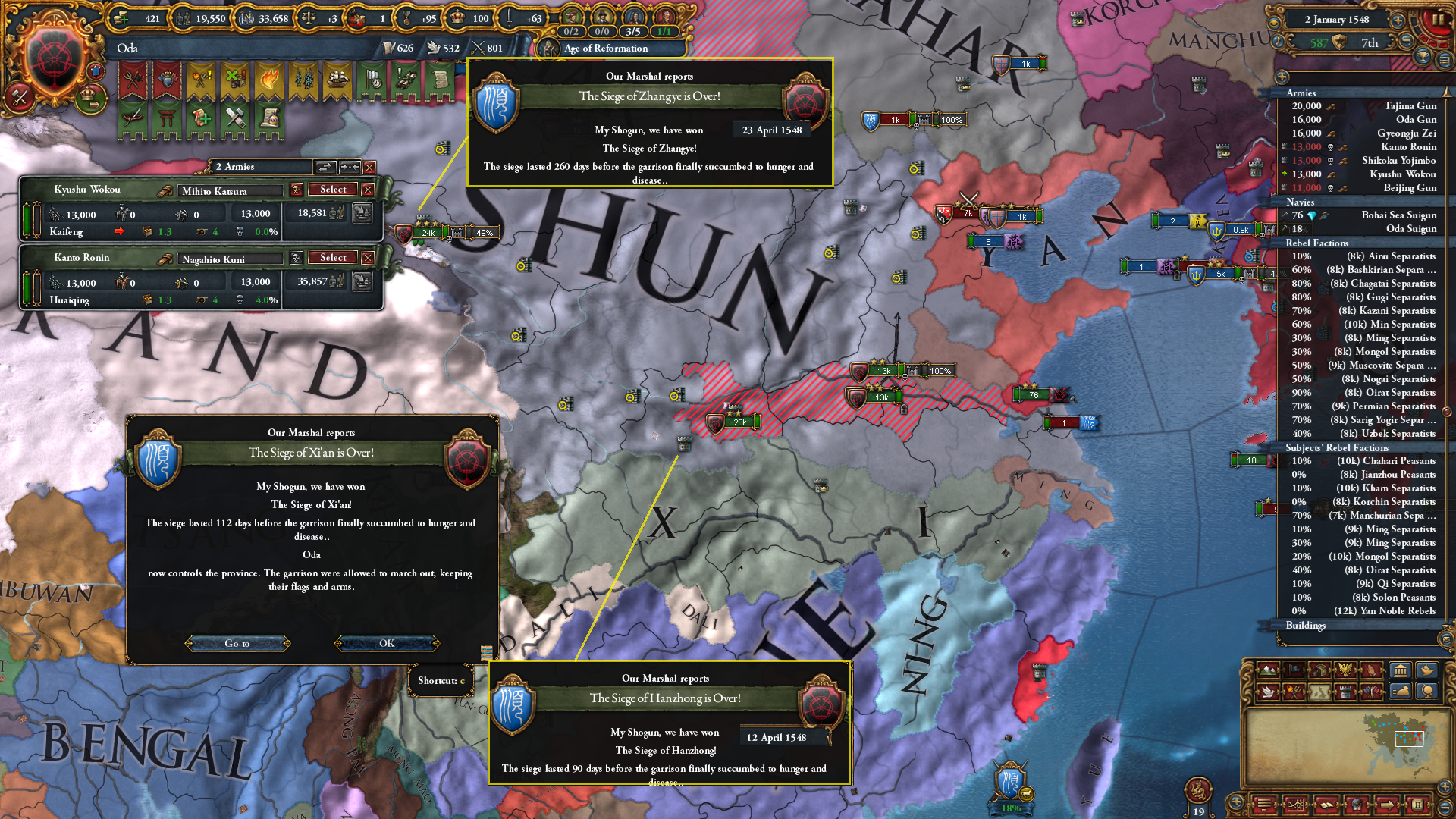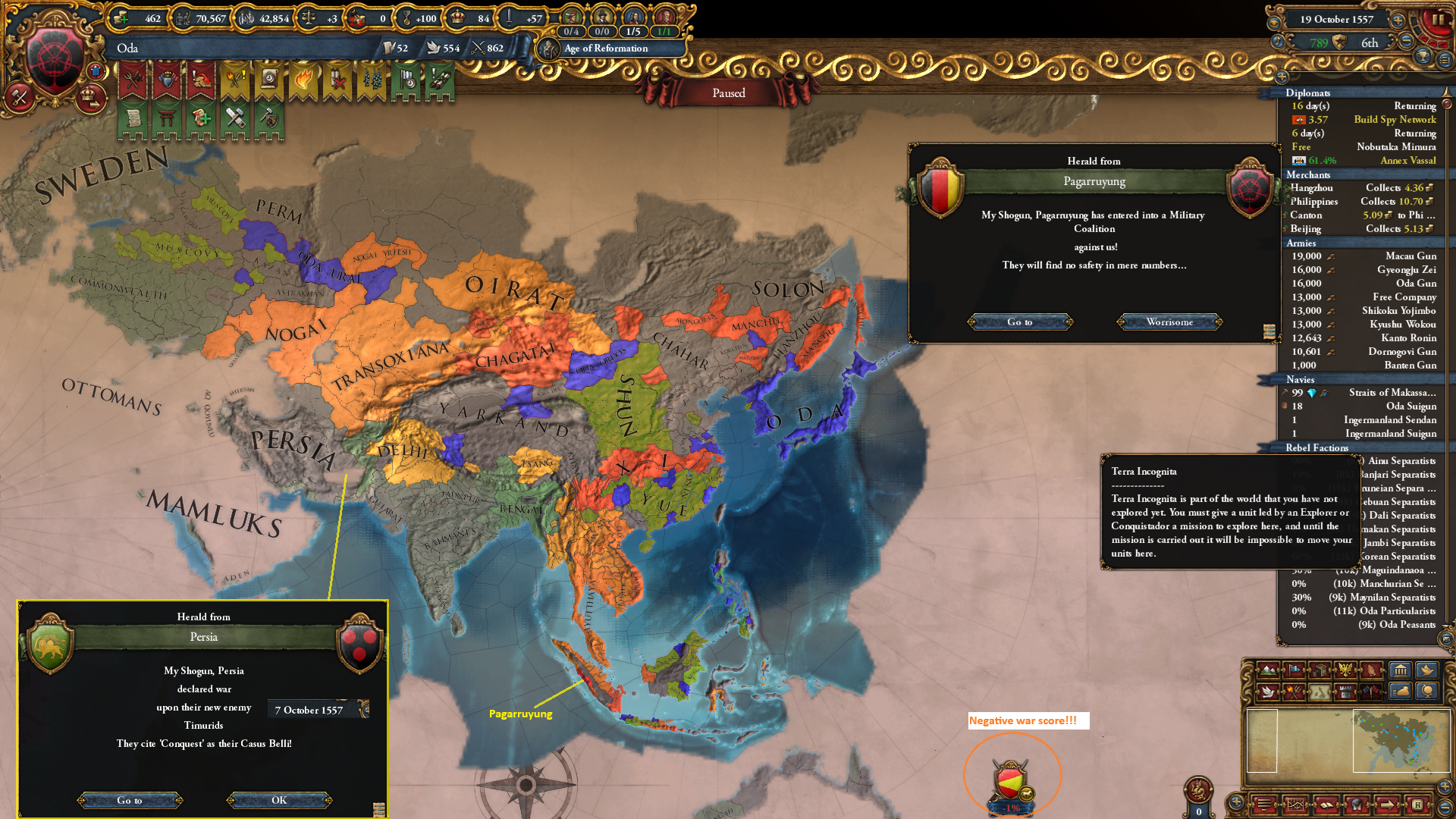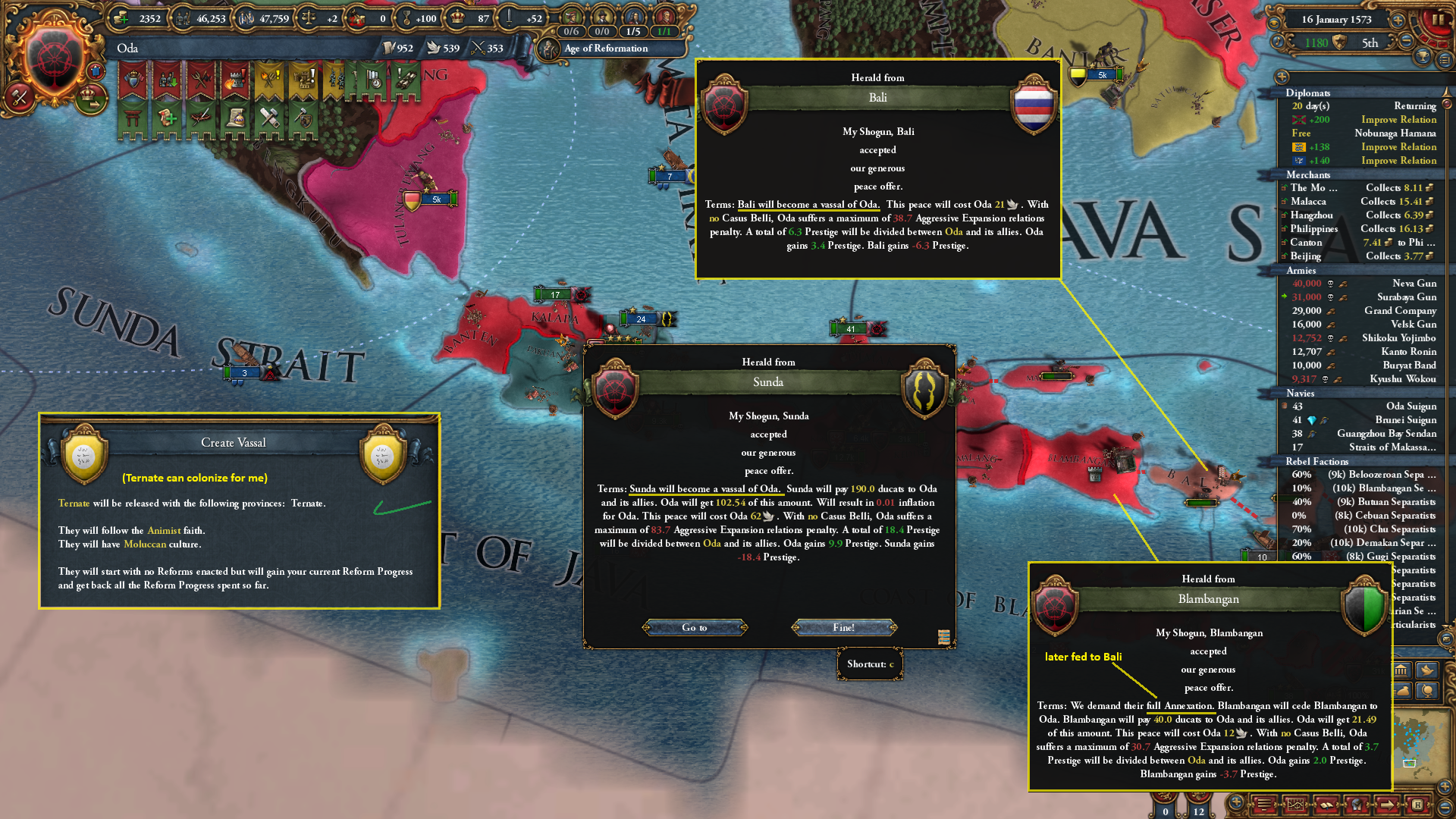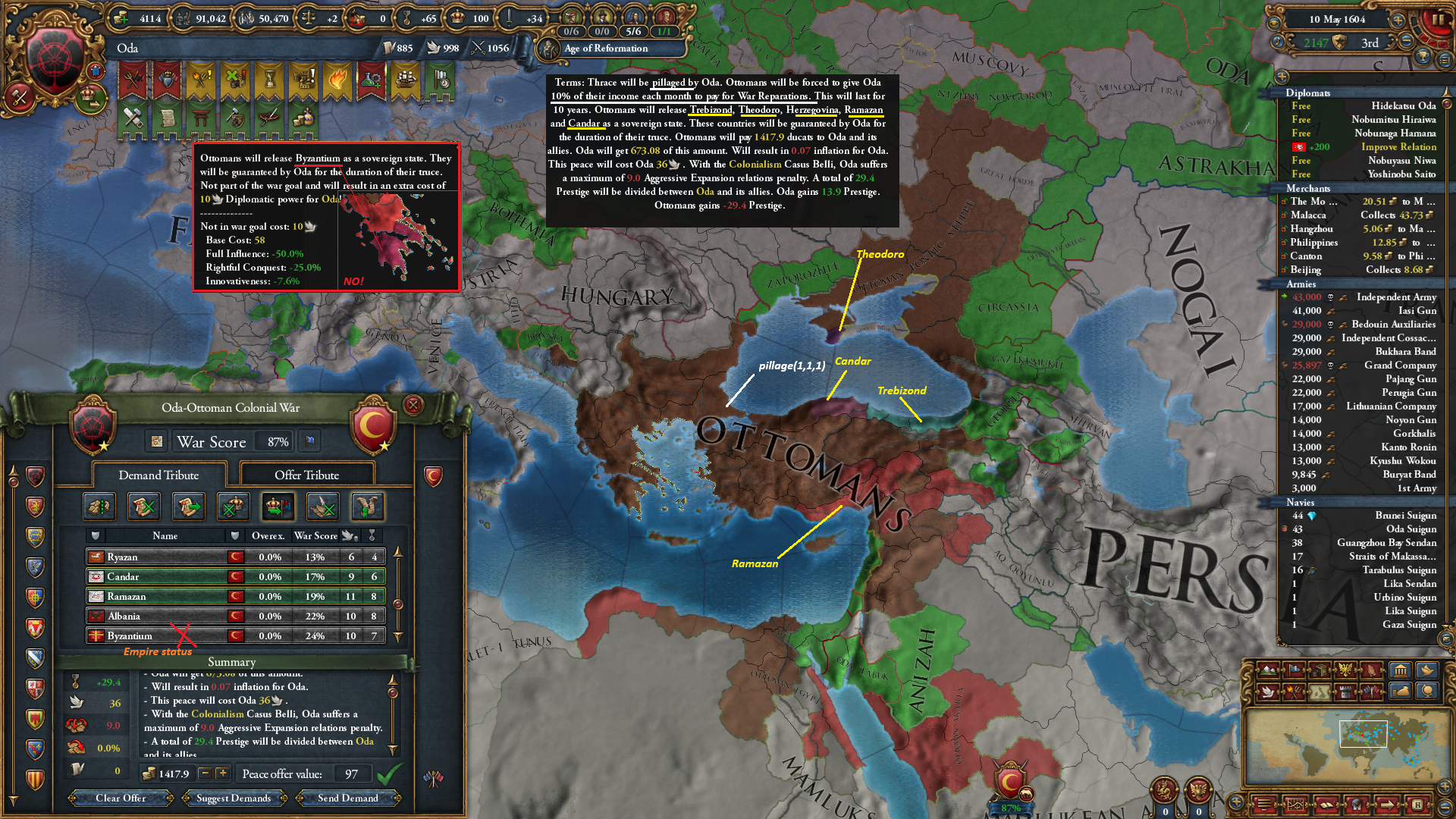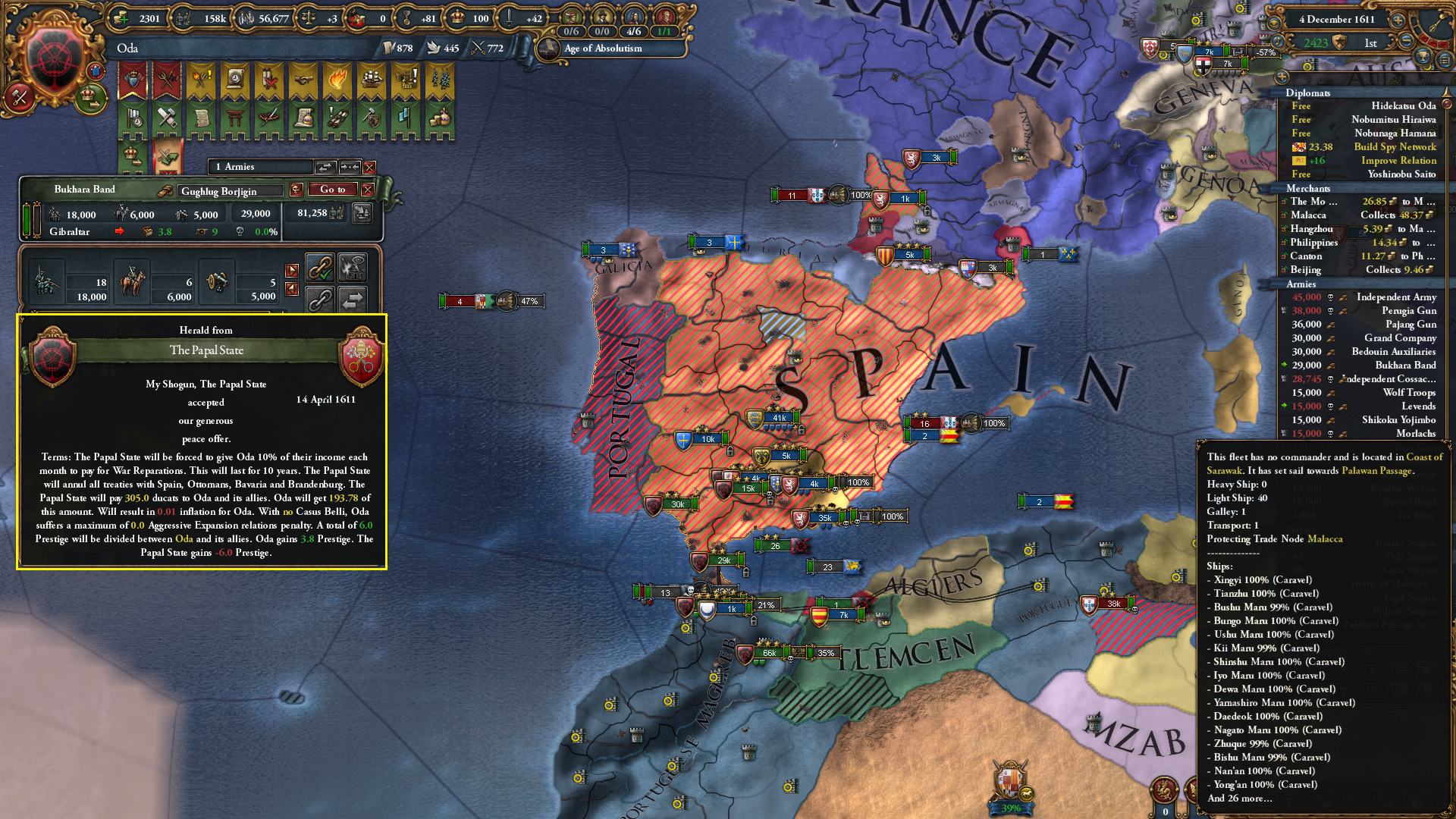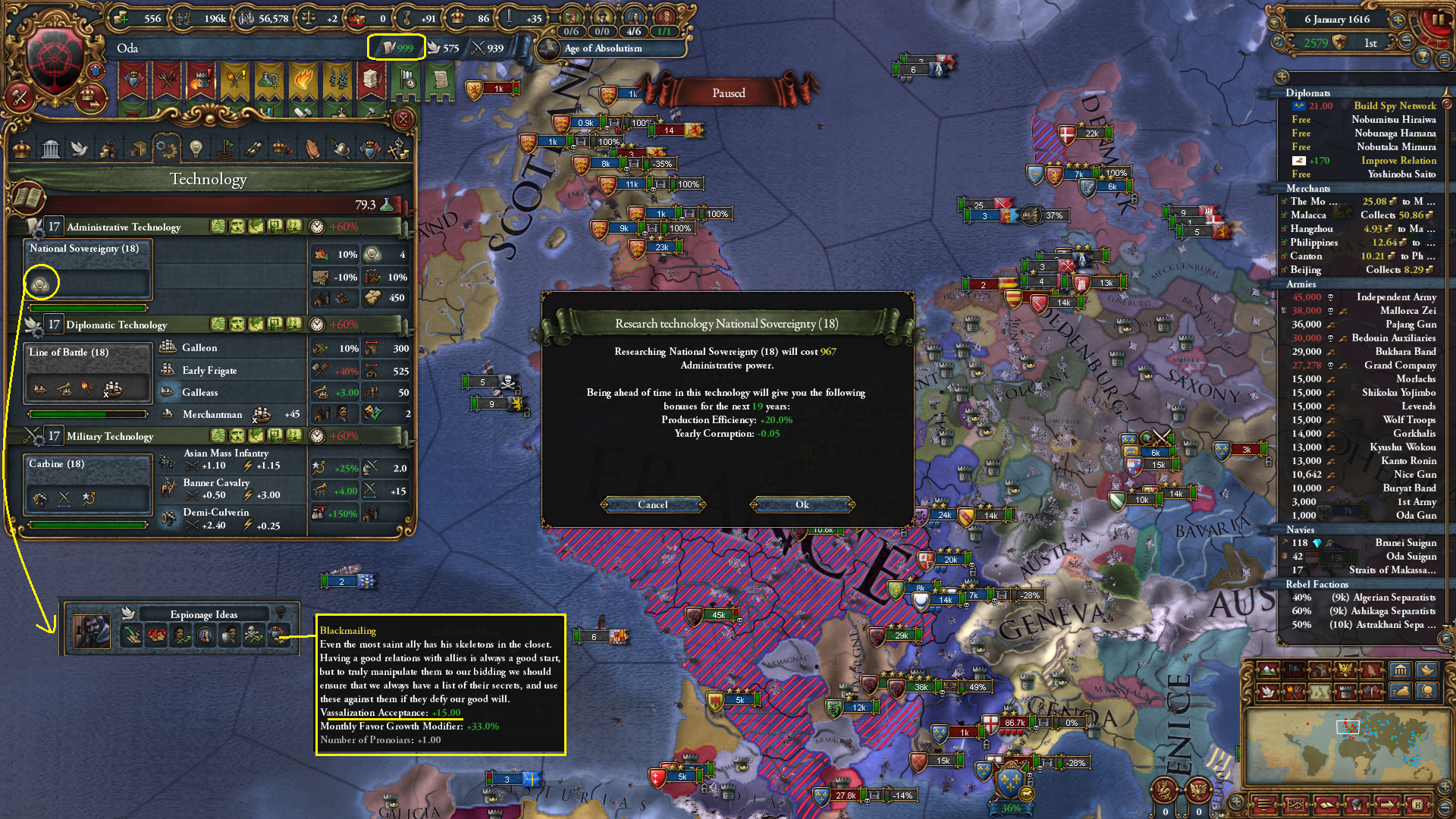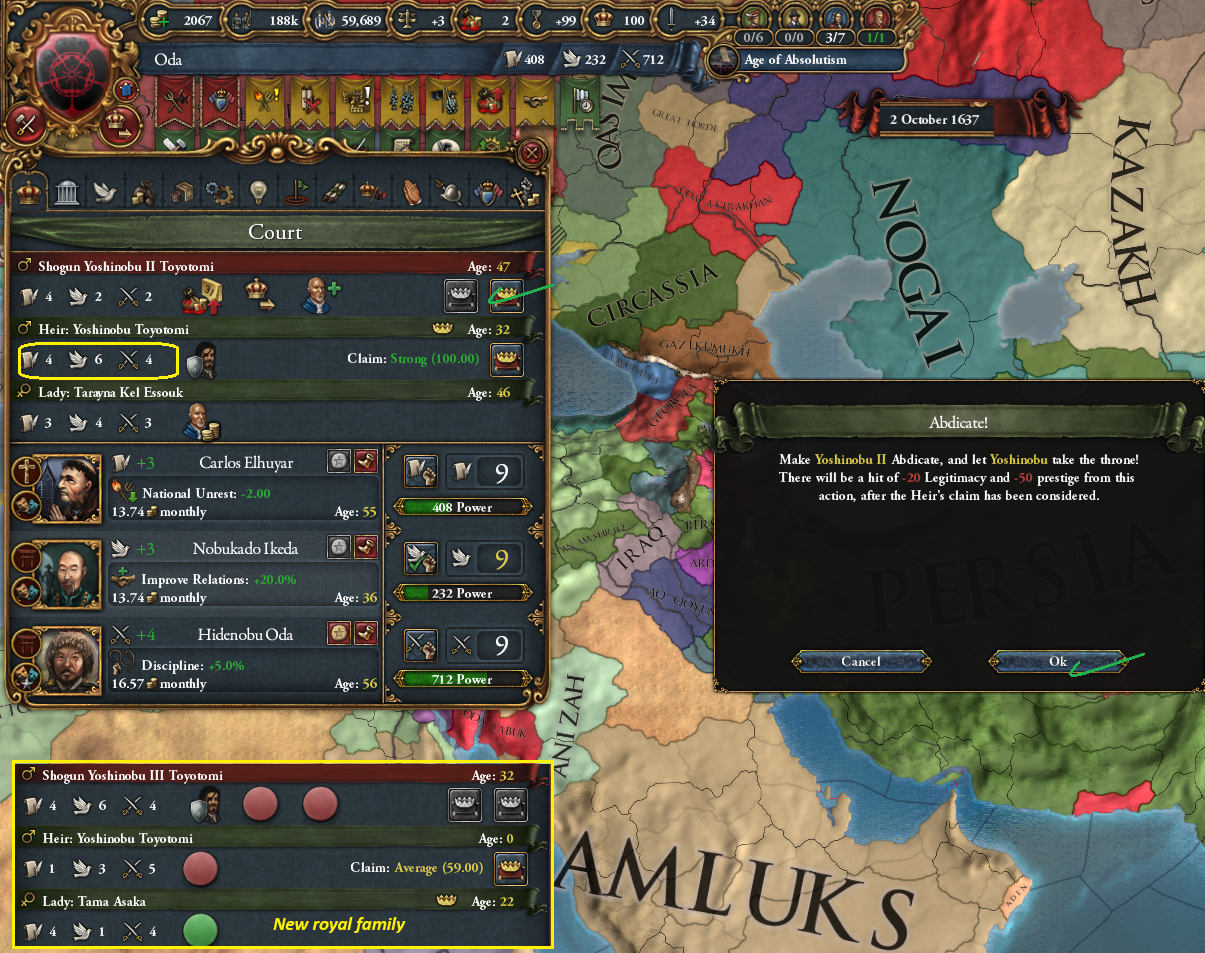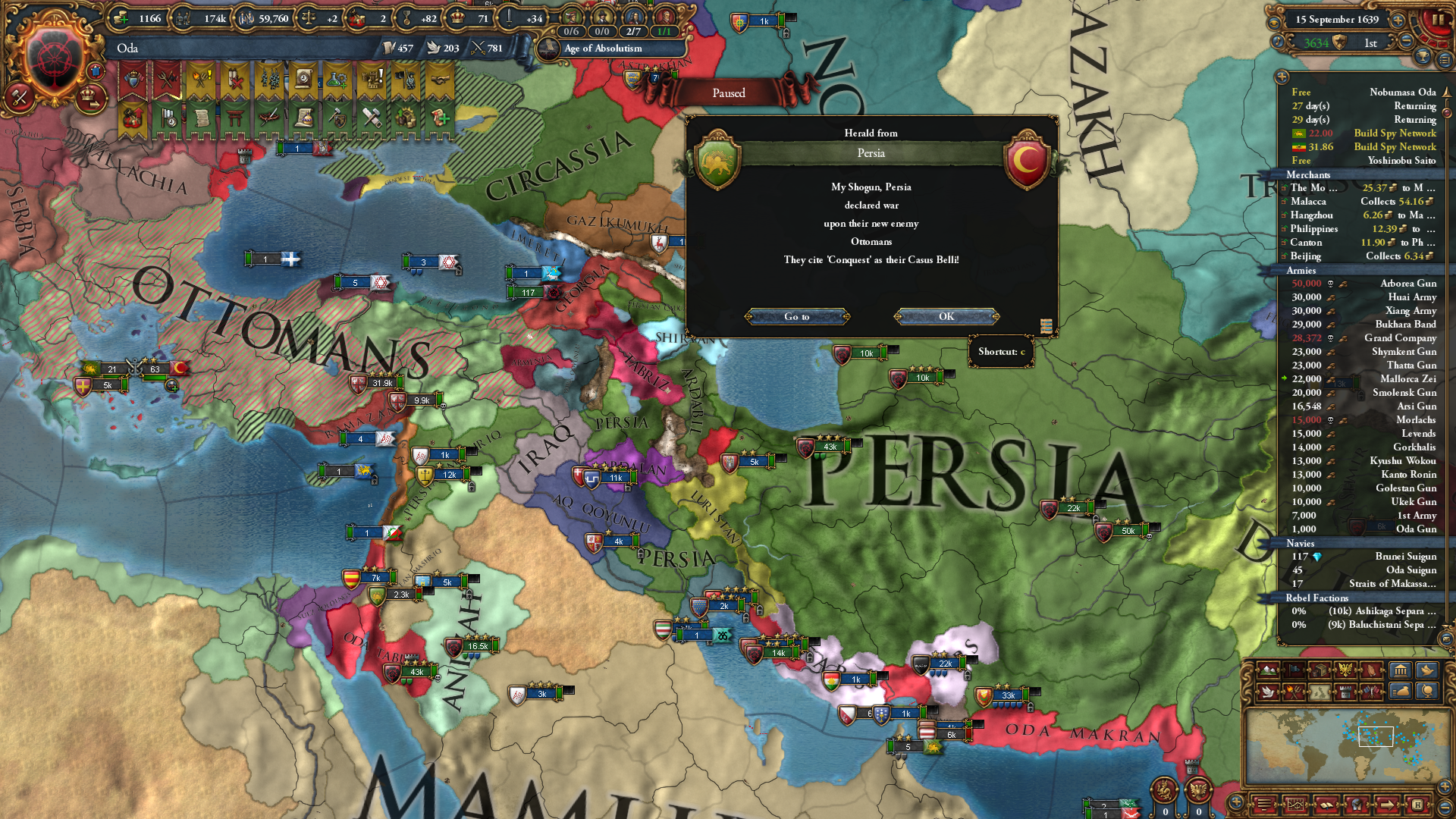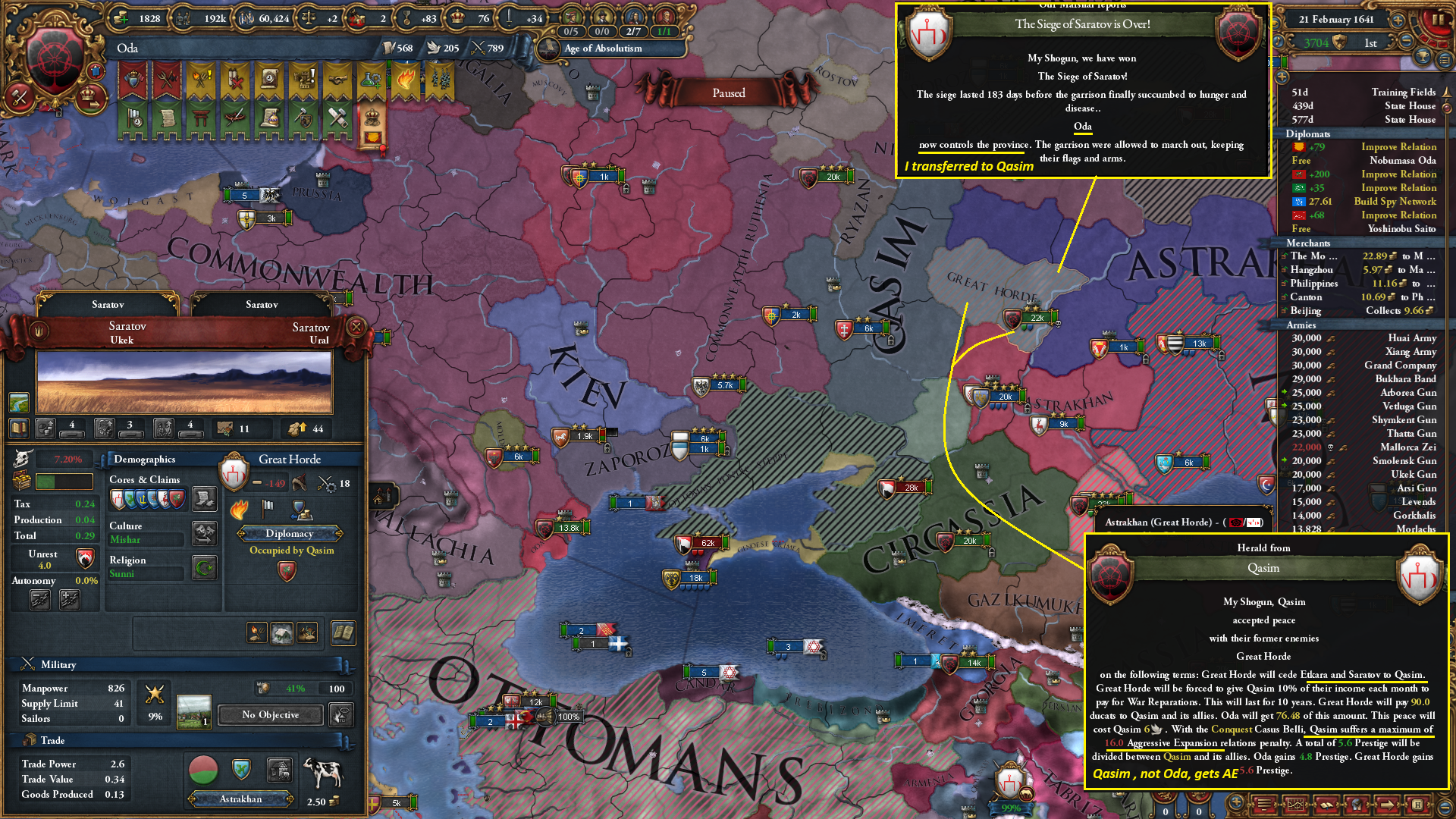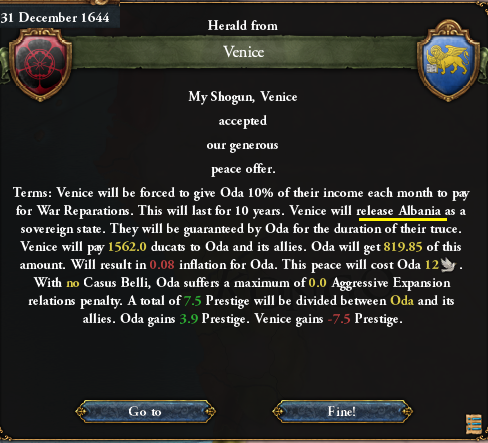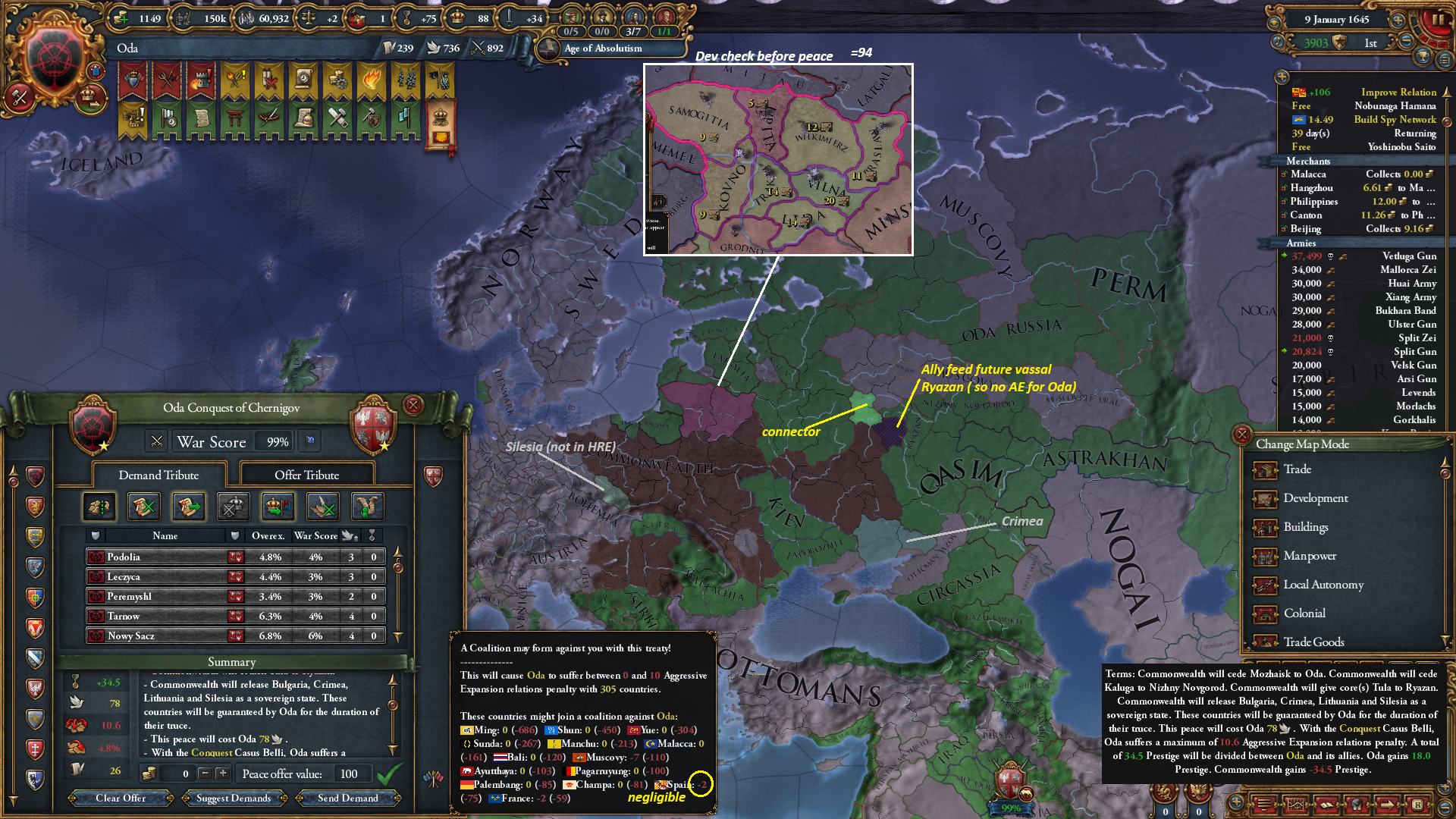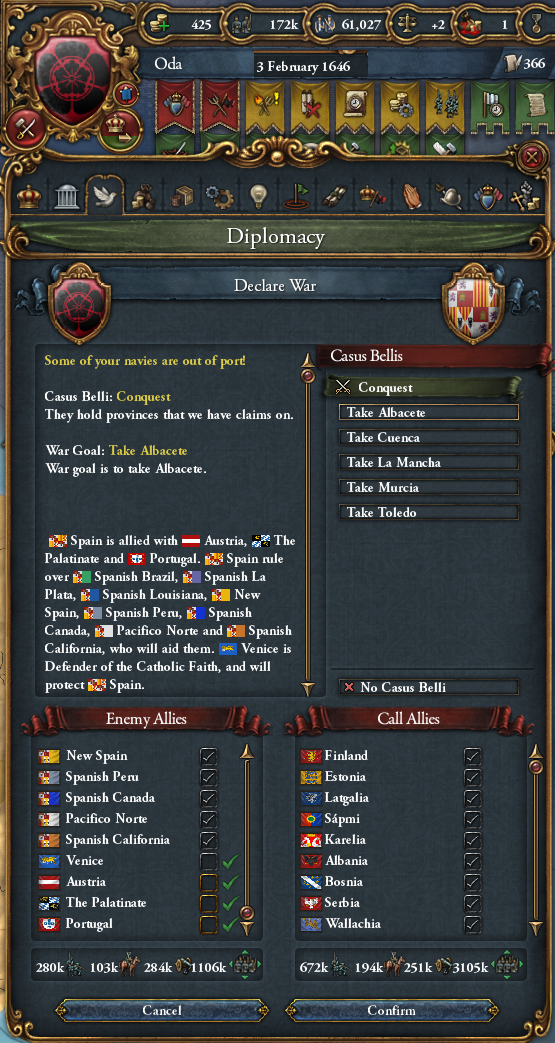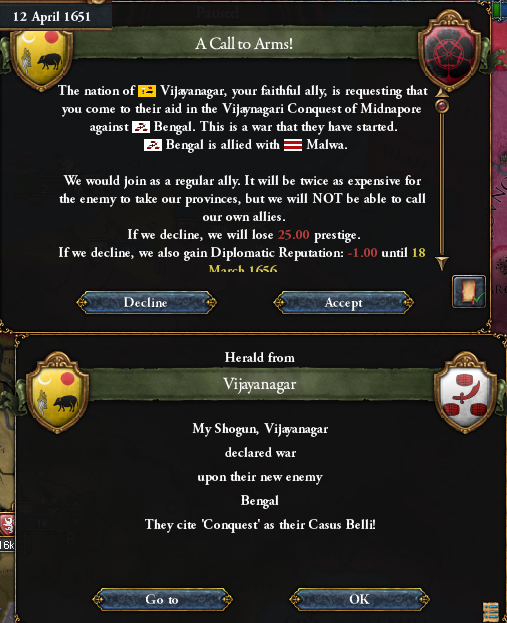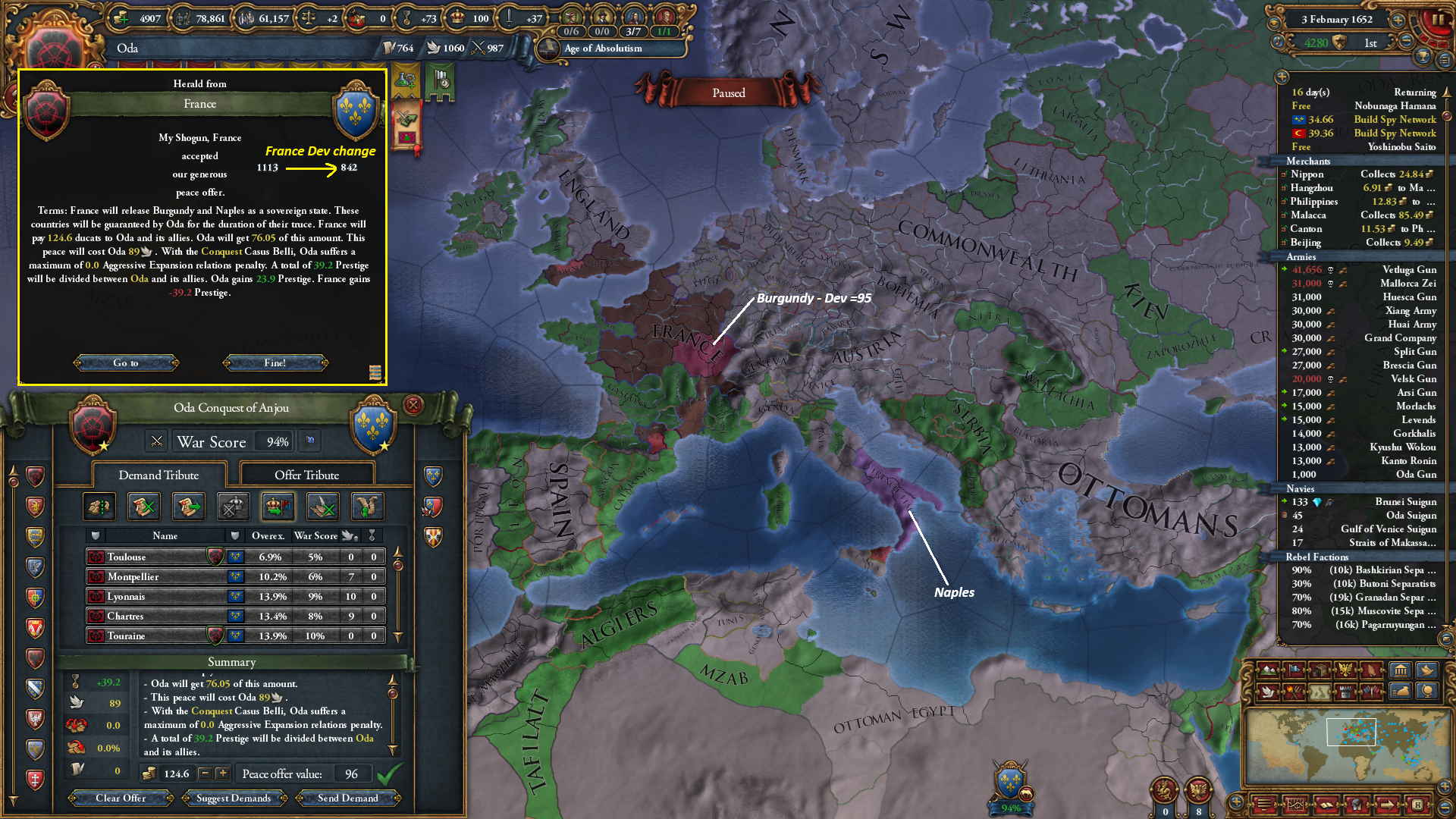Chapter 1: Oda Shows Its Strength (1444-1450)
On the morning of November 11, 1444 Lord Hisanaga, the 24 year old ruler of Oda, woke up with a voice in his head. That voice told him that one day his tiny nation will become the Empire slayer. Why Oda? Because Oda had a reputation as being one of the more , if not the most, militaristic Daimyos in Japan, a place teeming with nations with strong military traditions.

But his nation was also blessed with a great geographic location, in the middle of the big island Honshu, yet not adjacent to the larger Daimyos of Hosokawa , Uesugi and Yamana.

So Oda had options to expand before hitting serious resistance. Although one of her neighbors possessed one the 4 Castles on the Islands, effectively blocking expansion in that direction until Oda could afford a large enough army ( 9 regiments to be exact) to siege down the fort.
Lord Hisanagagot to work right away on Nov 11, immediately hiring an Army Reformer to boost his troops' morale. He then asked the three Estates for resource support in exchange of Crown Land. He then seized some of that crown land back. He did not grant the Estates any additional privileges to avoid them growing their influence ( similarly he did not summon the diet to avoid an influence boost to the Estates). You see, he knew that in the next 5 years Oda was going to expand, and the less influence the Estates had, the more land share would accrue to the Crown from the conquest.


But he did grant the Bushi the privilege of Officer Rights, and immediately recruited general Ikeda , skilled in fire , shock and siege warfare . That upset the Nobility greatly [-20 loyalty], which is why Hianage was careful to seize land before hiring the general ( the reverse order would have let to a rebellion ).

And still on that fateful Nov 11 day, he sent an envoy requesting marriage from his overlord Ashikaga ( to discourage the overlord from one day declaring war on Oda). And he recruited the Free Company in Owari ( Oda's capital), even though he did not know who was going to be his first target. He just wanted the troops ready as early as possible. And he tasked his merchant in Nippon with the side job of helping the spies through hostile trading


For Hisanaga knew that in any future war, the speed of siege completion was going to be the decisive factor in keeping Oda on a sound fiscal footing, and so he used every trick in the book to gain a siege .
After all these day 1 preparations, he rested and waited the mandatory month till Oda cold declare war. In that time, he received a request of an alliance from Yamana , one of the large Daimyos . He agreed to it, figuring that some protection from a larger nation was a good thing.

With all that out of the way, Dec 11 finally arrived and Oda could look at options to declare war. WIth the Sengoku Casus Belli, Oda could choose any of her 3 immediate neihgbors. Unfortunately the two smaller ones had obtained strong allies, and were therefore not good targets. The third neighbor, Toki , had the fort of Mino which made it impossible for Oda to siege down without recruiting a very expensive force .

But that did not mean Oda had to sit idle and watch the other Daimyos jockey for position. After all, the Free company was already recruited and costing the treasury money. So Hisanaga looked for potential rivals to humiliate , and he settled on Issihiki, a Daimyo on the West coast, allied to Imawaga on the East Coast. Both were valid rivals for Oda. And so ignoring the other nations that had rivaled Oda, he designated those two as enemies of Oda. And then a month later, with the humiliate CB in hand, he declared Oda's first war ( one of many , we hope) .

Oda's strategy was to first besiege Imawaga , then humiliate them [for Age Objective] and take money from them, then turn around to fully occupy Issihiki and obtain resources [Mana] from them by showing strength.

The first engagement of the war went according to plan. With 7,000 troops to Imawaga's 3000 , and with the benefit of the morale boost from the advisor, Oda's military traditions, and general Ikeda, it was no surprise that Imawaga's army was annihilated.

With numerical superiority now assured over the remaining enemy, Hisanaga consolidated his 3 regular regiments into two, to alleviate the money drain on the treasury ( and preserve manpower ) . He even lowered the salary maintenance of the regular troops ( mercenaries are not affected by that) and moved them off the siege .

With these actions, the treasury of Oda was expected to last about 10 months, hopefully enough to complete the Imawaga siege. And to speed up that siege, he decided to call on the Merchant estate for an admiral.

Oda's fleet was basically equal in size to Imawaga's . But with the benefit of a skilled admiral, the Odans had the advantage and the enemy allowed them to blockade their city . But while Hisanaga's attention was drawn to that, the enemy army of Issihiki snuck up on his regular regiment stationed nearby and annihilated it

There was a silver lining in that defeat as the Odan army now had a total of 5 regiments, closer to its force limit of 4 . And therefore much more affordable. And it turned out that the mercenary troops alone were more than capable of wiping out the Issihiki force in a revenge engagement at Sagami.

With the Issihiki army destroyed, Oda sent the lone remaining regular regiment to their capital to prevent recruitment of more troops. But they found it already under siege by Yamana in another war

And when the enemy capital fell, Yamana annexed them completely. That led Imagawa to become the war leader against Oda. ANd when their capital fell, they surrendered unconditionally .

In the peace, Oda showed strength over Imagawa gaining lots of resources as well as power projection in the process.
Now in many parts of the world, one would rest after such a victory over their rivals. But in the dog-eats-dog world of Daimyo politics, such an attitude was for the weak . And so immediately Hisanaga looked for fresh war targets. And he noticed that his neighbor Tokugawa's allies were distracted and would not defend them. He jumped on the opportunity, first designating Tokugawa a rival, and then immediately declaring war.
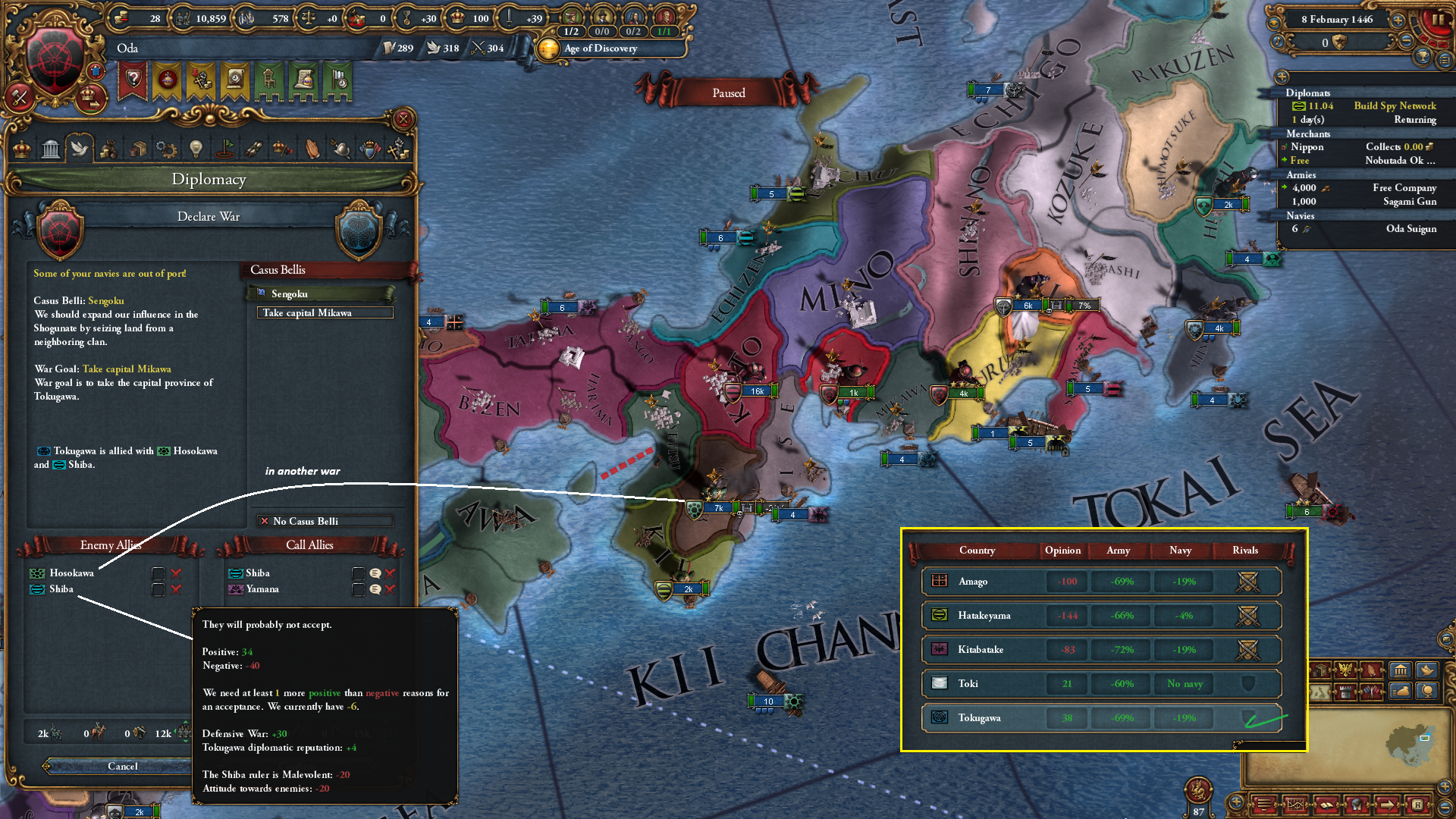
The Tokugawan army was already away fighting alongside Hosokawa, and so the "war" was just the siege of their capital, facilitated by the fleet. After 241 days, the city fell and was promptly annexed , effectively doubling Oda's size overnight

During that happy war another happy event happened, namely the birth of a promising heir named Hidenobu. May he live and avoid hunting accidents!
After that Hisanaga looked for fresh targets, and settled on the nation of Hakateyama, who owned the province of Kii that was claimed by Oda. They were allied to powerful Hosokawa, but it appeared that Hosokawa was unwilling to defend them . So Oda set them as rival and prepared for war. But when war was about to be declared, Hosokawa decided they would help them after all. Oda demurred and cancelled the attack.

Undeterred Hisanaga kept searching for targets and noticed that Kitabatake to his west had no protection, as their main ally Uesugi was occupied. So he declared on them

Kitabatake was allied to Amago, who was a small minor but owned one of the 4 forts in Japan . The fighting with Ktabatake was straightforward. Their army was annihilated and their capital city of Ise taken by siege, thanks to the blockade by the fleet

But to fully annex them , Oda needed the enemy to surrender. With Amago in the fight still , that seemed impossible. Oda's leader considered a partial peace - such as humiliation and taking money - but decided against it. Ise province was part of Oda's capital area, and he really wanted to annex it before another larger Daimyo did . So he decided to be patient, and see if Amago would leave the war eventually
And his patience soon paid off as TOki declared war on Kitatbatake which meant they could assist in the siege of Amago if it came to that. And then Amago for some reason decided to venture their army out towards either Toki or Oda, and general Ikeda was able to ambush them and annihilate them .

With the enemy capital occupied, and with the enemy out of troops completely, the ruler of Kitabatake surrendered without waiting for his ally's fort to tbe taken . Oda immediately annexed her former rival and neighbor.

One effect of that annexation was giving Oda a border - and therefore the mutual Sengoku casus belli - with the powerful Hosokawa. As a token of non-aggression, Oda offered Hosakawa a royal marriag which they accepted.
Oda had now grown to three provinces. Hisanaga felt this was a good size for now. Adding more territory meant more rebels, and he wanted Oda to better integrate the lands she already took . But that did not mean no wars. For to his Northwest lay the weak nation of Osagawara.

After designating Osagwara a rival, war was declared. They were allied to Date , and together they had 5000 troops, the same as Oda ( 4,000 from free company and one regular regiment) . But Oda had better military tradition and generals . And soon had better military tactics thanks to the early adoption of Pike Square ( doubtless helped by the earlier Show Strength peace treaty with Imawaga)

The superior Oda military meant no battles had to be fought in this war as first the Osagawaran capital was taken, then the Date capital without the enemy challenging Odan armies. Peace was then concluded, wth Date getting pillaged and paying money and reparataions. And with Ogasawara yielding to Oda's show of strength which earned Oda lots of resources [100 Mana each]

Hisanaga was very pleased with this peace, although his celebration was marred by the overlord Ashikaga stealing - like a dirty thief - some of Owari' development.

Those events bring us almost to the end of the decade. Oda is ready for another war, but first a couple of internal items were taken care of . First, more Crown Land was seized despite the unhappiness of the estates .

Second, the old Estate loans were paid off and new - larger- ones were taken .

That meant there was enough money in the treasury to hire a second mercenary company, which can be used to finally siege down the strategic fort of Mino to the west of Oda.

We close the chapter with the map of Japan showing Oda, now a three province Daimyo , in the middle of it.

Some notes on the first chapter.
* This is my first run in Japan, and I have to tell you it feels different from other starts. What I showed above was my 4th attempt, as I learned a few lessons in my first three. My first attempt ended when I declared war without setting rivals and I set up the estates wrong ( I gave them too many privileges and so had high influence and I could not get Crown Land back from conquest). The second attempt, I abandoned after I finished my first war with 14 loans due to simultaneously sieging two sea provinces without the fleet blockading . Took forever and was too much over force limit. Third attempt was very promising ( Ashikaga even gifted me 25 ducats, a huge sum equal to 5 loans at the time). but I made a blunder when I split my army to chase an enemy stack and ended up defeated on the battlefield . You cannot afford lost battles in the competitive Japan cauldron .
* choice of Oda was relatively easy. I looked up some guides and posts on the forum, and I say the Wiki summary I put in the screenshot was spot on . The larger Daimyos are balanced by having slightly worse ideas. Since I am playing a looong campaign, the National Ideas will long remain relevant while we forget our starting position.
* My day one moves were to hire a morale or discipline advisor and an estate general with at least 1 siege pip and 2 shock. When those did not happen, I re-rolled. I did not want to risk my above-average ruler as a general.
* There is a debate on the forums and in the guides whether you should just blob fast, or do some "Show Strength" to get mana. I did a mix of two. I did 2 humiliation wars with Show Strength. And took land in 2 . I think I will continue to do this so that I can spawn Renaissance in Owari , but also not let other Daimyos gobble up all the land. If I understand rules correctly, the Shogun will not declare war on a Daimyo unless they hit 10 provinces. So when I hit 10 provinces, I want one of them to be highly developed.
On the morning of November 11, 1444 Lord Hisanaga, the 24 year old ruler of Oda, woke up with a voice in his head. That voice told him that one day his tiny nation will become the Empire slayer. Why Oda? Because Oda had a reputation as being one of the more , if not the most, militaristic Daimyos in Japan, a place teeming with nations with strong military traditions.

But his nation was also blessed with a great geographic location, in the middle of the big island Honshu, yet not adjacent to the larger Daimyos of Hosokawa , Uesugi and Yamana.

So Oda had options to expand before hitting serious resistance. Although one of her neighbors possessed one the 4 Castles on the Islands, effectively blocking expansion in that direction until Oda could afford a large enough army ( 9 regiments to be exact) to siege down the fort.
Lord Hisanagagot to work right away on Nov 11, immediately hiring an Army Reformer to boost his troops' morale. He then asked the three Estates for resource support in exchange of Crown Land. He then seized some of that crown land back. He did not grant the Estates any additional privileges to avoid them growing their influence ( similarly he did not summon the diet to avoid an influence boost to the Estates). You see, he knew that in the next 5 years Oda was going to expand, and the less influence the Estates had, the more land share would accrue to the Crown from the conquest.


But he did grant the Bushi the privilege of Officer Rights, and immediately recruited general Ikeda , skilled in fire , shock and siege warfare . That upset the Nobility greatly [-20 loyalty], which is why Hianage was careful to seize land before hiring the general ( the reverse order would have let to a rebellion ).

And still on that fateful Nov 11 day, he sent an envoy requesting marriage from his overlord Ashikaga ( to discourage the overlord from one day declaring war on Oda). And he recruited the Free Company in Owari ( Oda's capital), even though he did not know who was going to be his first target. He just wanted the troops ready as early as possible. And he tasked his merchant in Nippon with the side job of helping the spies through hostile trading


For Hisanaga knew that in any future war, the speed of siege completion was going to be the decisive factor in keeping Oda on a sound fiscal footing, and so he used every trick in the book to gain a siege .
After all these day 1 preparations, he rested and waited the mandatory month till Oda cold declare war. In that time, he received a request of an alliance from Yamana , one of the large Daimyos . He agreed to it, figuring that some protection from a larger nation was a good thing.

With all that out of the way, Dec 11 finally arrived and Oda could look at options to declare war. WIth the Sengoku Casus Belli, Oda could choose any of her 3 immediate neihgbors. Unfortunately the two smaller ones had obtained strong allies, and were therefore not good targets. The third neighbor, Toki , had the fort of Mino which made it impossible for Oda to siege down without recruiting a very expensive force .

But that did not mean Oda had to sit idle and watch the other Daimyos jockey for position. After all, the Free company was already recruited and costing the treasury money. So Hisanaga looked for potential rivals to humiliate , and he settled on Issihiki, a Daimyo on the West coast, allied to Imawaga on the East Coast. Both were valid rivals for Oda. And so ignoring the other nations that had rivaled Oda, he designated those two as enemies of Oda. And then a month later, with the humiliate CB in hand, he declared Oda's first war ( one of many , we hope) .

Oda's strategy was to first besiege Imawaga , then humiliate them [for Age Objective] and take money from them, then turn around to fully occupy Issihiki and obtain resources [Mana] from them by showing strength.

The first engagement of the war went according to plan. With 7,000 troops to Imawaga's 3000 , and with the benefit of the morale boost from the advisor, Oda's military traditions, and general Ikeda, it was no surprise that Imawaga's army was annihilated.

With numerical superiority now assured over the remaining enemy, Hisanaga consolidated his 3 regular regiments into two, to alleviate the money drain on the treasury ( and preserve manpower ) . He even lowered the salary maintenance of the regular troops ( mercenaries are not affected by that) and moved them off the siege .

With these actions, the treasury of Oda was expected to last about 10 months, hopefully enough to complete the Imawaga siege. And to speed up that siege, he decided to call on the Merchant estate for an admiral.

Oda's fleet was basically equal in size to Imawaga's . But with the benefit of a skilled admiral, the Odans had the advantage and the enemy allowed them to blockade their city . But while Hisanaga's attention was drawn to that, the enemy army of Issihiki snuck up on his regular regiment stationed nearby and annihilated it

There was a silver lining in that defeat as the Odan army now had a total of 5 regiments, closer to its force limit of 4 . And therefore much more affordable. And it turned out that the mercenary troops alone were more than capable of wiping out the Issihiki force in a revenge engagement at Sagami.

With the Issihiki army destroyed, Oda sent the lone remaining regular regiment to their capital to prevent recruitment of more troops. But they found it already under siege by Yamana in another war

And when the enemy capital fell, Yamana annexed them completely. That led Imagawa to become the war leader against Oda. ANd when their capital fell, they surrendered unconditionally .

In the peace, Oda showed strength over Imagawa gaining lots of resources as well as power projection in the process.
Now in many parts of the world, one would rest after such a victory over their rivals. But in the dog-eats-dog world of Daimyo politics, such an attitude was for the weak . And so immediately Hisanaga looked for fresh war targets. And he noticed that his neighbor Tokugawa's allies were distracted and would not defend them. He jumped on the opportunity, first designating Tokugawa a rival, and then immediately declaring war.

The Tokugawan army was already away fighting alongside Hosokawa, and so the "war" was just the siege of their capital, facilitated by the fleet. After 241 days, the city fell and was promptly annexed , effectively doubling Oda's size overnight

During that happy war another happy event happened, namely the birth of a promising heir named Hidenobu. May he live and avoid hunting accidents!
After that Hisanaga looked for fresh targets, and settled on the nation of Hakateyama, who owned the province of Kii that was claimed by Oda. They were allied to powerful Hosokawa, but it appeared that Hosokawa was unwilling to defend them . So Oda set them as rival and prepared for war. But when war was about to be declared, Hosokawa decided they would help them after all. Oda demurred and cancelled the attack.

Undeterred Hisanaga kept searching for targets and noticed that Kitabatake to his west had no protection, as their main ally Uesugi was occupied. So he declared on them

Kitabatake was allied to Amago, who was a small minor but owned one of the 4 forts in Japan . The fighting with Ktabatake was straightforward. Their army was annihilated and their capital city of Ise taken by siege, thanks to the blockade by the fleet

But to fully annex them , Oda needed the enemy to surrender. With Amago in the fight still , that seemed impossible. Oda's leader considered a partial peace - such as humiliation and taking money - but decided against it. Ise province was part of Oda's capital area, and he really wanted to annex it before another larger Daimyo did . So he decided to be patient, and see if Amago would leave the war eventually
And his patience soon paid off as TOki declared war on Kitatbatake which meant they could assist in the siege of Amago if it came to that. And then Amago for some reason decided to venture their army out towards either Toki or Oda, and general Ikeda was able to ambush them and annihilate them .

With the enemy capital occupied, and with the enemy out of troops completely, the ruler of Kitabatake surrendered without waiting for his ally's fort to tbe taken . Oda immediately annexed her former rival and neighbor.

One effect of that annexation was giving Oda a border - and therefore the mutual Sengoku casus belli - with the powerful Hosokawa. As a token of non-aggression, Oda offered Hosakawa a royal marriag which they accepted.
Oda had now grown to three provinces. Hisanaga felt this was a good size for now. Adding more territory meant more rebels, and he wanted Oda to better integrate the lands she already took . But that did not mean no wars. For to his Northwest lay the weak nation of Osagawara.

After designating Osagwara a rival, war was declared. They were allied to Date , and together they had 5000 troops, the same as Oda ( 4,000 from free company and one regular regiment) . But Oda had better military tradition and generals . And soon had better military tactics thanks to the early adoption of Pike Square ( doubtless helped by the earlier Show Strength peace treaty with Imawaga)

The superior Oda military meant no battles had to be fought in this war as first the Osagawaran capital was taken, then the Date capital without the enemy challenging Odan armies. Peace was then concluded, wth Date getting pillaged and paying money and reparataions. And with Ogasawara yielding to Oda's show of strength which earned Oda lots of resources [100 Mana each]

Hisanaga was very pleased with this peace, although his celebration was marred by the overlord Ashikaga stealing - like a dirty thief - some of Owari' development.

Those events bring us almost to the end of the decade. Oda is ready for another war, but first a couple of internal items were taken care of . First, more Crown Land was seized despite the unhappiness of the estates .

Second, the old Estate loans were paid off and new - larger- ones were taken .

That meant there was enough money in the treasury to hire a second mercenary company, which can be used to finally siege down the strategic fort of Mino to the west of Oda.

We close the chapter with the map of Japan showing Oda, now a three province Daimyo , in the middle of it.

Some notes on the first chapter.
* This is my first run in Japan, and I have to tell you it feels different from other starts. What I showed above was my 4th attempt, as I learned a few lessons in my first three. My first attempt ended when I declared war without setting rivals and I set up the estates wrong ( I gave them too many privileges and so had high influence and I could not get Crown Land back from conquest). The second attempt, I abandoned after I finished my first war with 14 loans due to simultaneously sieging two sea provinces without the fleet blockading . Took forever and was too much over force limit. Third attempt was very promising ( Ashikaga even gifted me 25 ducats, a huge sum equal to 5 loans at the time). but I made a blunder when I split my army to chase an enemy stack and ended up defeated on the battlefield . You cannot afford lost battles in the competitive Japan cauldron .
* choice of Oda was relatively easy. I looked up some guides and posts on the forum, and I say the Wiki summary I put in the screenshot was spot on . The larger Daimyos are balanced by having slightly worse ideas. Since I am playing a looong campaign, the National Ideas will long remain relevant while we forget our starting position.
* My day one moves were to hire a morale or discipline advisor and an estate general with at least 1 siege pip and 2 shock. When those did not happen, I re-rolled. I did not want to risk my above-average ruler as a general.
* There is a debate on the forums and in the guides whether you should just blob fast, or do some "Show Strength" to get mana. I did a mix of two. I did 2 humiliation wars with Show Strength. And took land in 2 . I think I will continue to do this so that I can spawn Renaissance in Owari , but also not let other Daimyos gobble up all the land. If I understand rules correctly, the Shogun will not declare war on a Daimyo unless they hit 10 provinces. So when I hit 10 provinces, I want one of them to be highly developed.
- 4
- 1
- 1

















